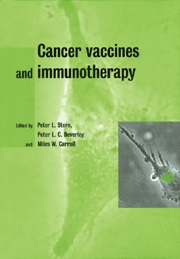Book contents
- Frontmatter
- Contents
- List of contributors
- 1 Immunity and cancer
- 2 Immunotherapy of bladder cancer
- 3 Poxviruses as vectors for cancer immunotherapy
- 4 Vaccinia-based human papillomavirus vaccines in cervical cancer
- 5 Vaccine delivery and immunosuppression in cervical cancer
- 6 Vaccines for colon cancer
- 7 MUC1 vaccines and breast cancer
- 8 Anti-idiotypic vaccination
- 9 Immunotherapy and vaccination against Epstein–Barr virus-associated cancer
- 10 Serologically identified tumour antigens as cancer vaccines
- 11 CTL-defined cancer vaccines in melanoma and other epithelial cancers
- 12 DNA vaccines against B-cell tumours
- 13 Dendritic cell approaches to immunotherapy
- 14 Overview
- 15 Recent developments
- Index
13 - Dendritic cell approaches to immunotherapy
Published online by Cambridge University Press: 06 January 2010
- Frontmatter
- Contents
- List of contributors
- 1 Immunity and cancer
- 2 Immunotherapy of bladder cancer
- 3 Poxviruses as vectors for cancer immunotherapy
- 4 Vaccinia-based human papillomavirus vaccines in cervical cancer
- 5 Vaccine delivery and immunosuppression in cervical cancer
- 6 Vaccines for colon cancer
- 7 MUC1 vaccines and breast cancer
- 8 Anti-idiotypic vaccination
- 9 Immunotherapy and vaccination against Epstein–Barr virus-associated cancer
- 10 Serologically identified tumour antigens as cancer vaccines
- 11 CTL-defined cancer vaccines in melanoma and other epithelial cancers
- 12 DNA vaccines against B-cell tumours
- 13 Dendritic cell approaches to immunotherapy
- 14 Overview
- 15 Recent developments
- Index
Summary
Introduction
While the term ‘magic bullet’ has resulted in the association of cancer immunotherapy with the use of monoclonal antibodies to target tumours, it is clear that the most effective way to exploit the immune system to clear tumours is by generating tumour-specific cytotoxic T cells (CTLs). The major question for cancer immunotherapy must thus be, how can an effective antitumour CTL response best be elicited? The surprisingly universal answer that has emerged from a number of different studies is that this requires the stimulation of T cells by a specific antigen-presenting cell (APC), the dendritic cell (DC). DCs were first described as the morphologically distinct Langerhans cells in the skin and have since been shown to be the most efficient APC for the activation of naíve T cells. The main impetus for their study as APCs was the development of simple methods for the isolation of DC-precursors from blood and the expansion of these cells in vitro to yield potent APCs. For clinical researchers, DCs have the promise of providing a vehicle for effective anticancer immunotherapy. However, many questions remain. Is a defect in APC function a significant component of the failure of the immune system to eradicate cancer? Is the restoration of competent APC function sufficient to permit the execution of an effective CTL response (or is the augmentation of DC function sufficient to overcome other defects in a cell-mediated immune response to cancer)? What are the optimum schedules for the preparation and administration of DC?
- Type
- Chapter
- Information
- Cancer Vaccines and Immunotherapy , pp. 237 - 255Publisher: Cambridge University PressPrint publication year: 2000



